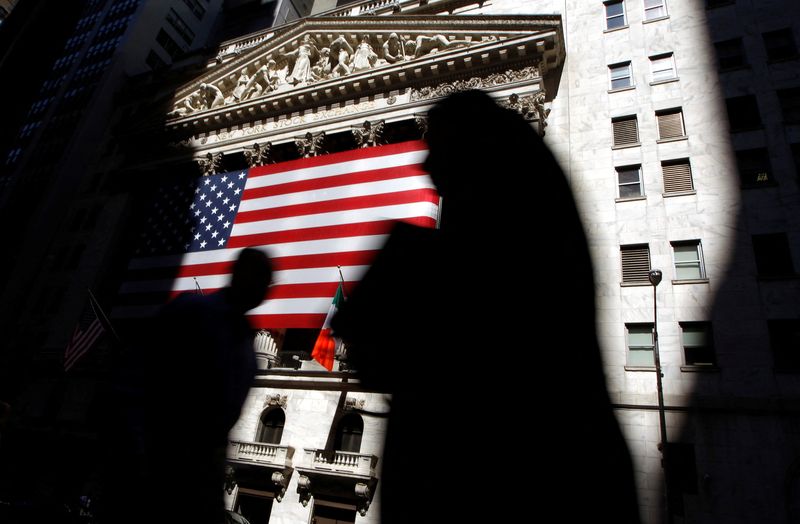Investing.com -- Stock futures inch into the green, hinting at an early rebound for equities following a losing week on Wall Street. Video conferencing group Zoom is due to report its latest quarterly earnings on Monday, while semiconductor giant Nvidia is on deck to unveil results on Wednesday. Elsewhere, China rolls out a new lending rate cut, but policymakers still face calls to do more to support the country's sputtering economic recovery.
1. Futures point higher
U.S. stock futures edged up on Monday, with the major indices on Wall Street coming off a losing week that featured surging bond yields and deepening worries over China's post-pandemic recovery.
At 05:15 ET (09:15 GMT), the Dow futures contract had moved higher by 102 points or 0.3%, the S&P 500 contract gained 19 points or 0.4%, and the Nasdaq 100 futures rose by 94 points or 0.6%.
Following a mixed session on Friday, the benchmark S&P 500, tech-heavy Nasdaq Composite, and the 30-stock Dow Jones Industrial Average all posted weekly declines. Equities came under pressure from a jump in bond yields that partly stemmed from waning hopes that the Federal Reserve will soon begin to back away from its long-standing monetary tightening campaign. Prices typically dip as yields rise.
As the new trading week begins in the U.S., investors will be looking ahead to comments on Friday from Fed Chair Jerome Powell at an annual symposium in Jackson Hole, Wyoming.
Meanwhile, weak economic releases have added fuel to concerns over how long it will take China to fully rebound from draconian COVID-19 rules. Calls for Beijing to roll out more stimulus to help spur demand in the world's second-largest economy have been intensifying, yet officials remain wary about causing further weakening in the yuan (see below).
2. Zoom to report with AI plans in focus
Video conferencing service Zoom (NASDAQ:ZM) is set to deliver its latest quarterly results after the bell on Monday, kicking off a fresh week of corporate returns.
Once a pandemic-era powerhouse driven by remote working, Zoom has been hit by more workers coming back to physical offices, along with rising competition from similar offerings backed by big-name players like Microsoft (NASDAQ:MSFT) and Google (NASDAQ:GOOGL). Revenue growth has slowed, while the company has slashed about a sixth of its headcount.
Zoom's leadership has outlined plans to use artificial intelligence to spruce up the business. Chief Executive Officer Eric Yuan recently said that the San Jose, California-based group is aiming to fold AI into almost all its features, arguing that the nascent technology has "a lot of monetization opportunities."
Traders seem unconvinced so far: Zoom shares have shed more than 8% of their value over the past six months.
The hype around AI will likely continue to take center stage this week, powered in particular by results from chipmaker Nvidia (NASDAQ:NVDA) and Chinese tech behemoth Baidu (NASDAQ:BIDU).
3. Strong cybersecurity demand boosts Palo Alto Networks
Shares in Palo Alto Networks (NASDAQ:PANW) climbed by over 12% in premarket U.S. trading on Monday after the cybersecurity group unveiled a better-than-expected estimate for annual billings.
The firm said it now anticipates that it will report billings of between $10.9 billion to $11 billion in its 2024 fiscal period, topping Bloomberg consensus estimates of $10.77B.
Billings in Palo Alto's fourth quarter came in slightly underestimated, although Chief Financial Officer Dipak Golechha noted that the figure did not capture the company's top-line strength.
The rosy outlook was enough to also lift shares in Palo Alto peers Zscaler (NASDAQ:ZS) and Fortinet (NASDAQ:FTNT).
These one-stop shops for cybersecurity solutions have seen a spike in demand from both businesses and governments following a spate of hacks and other digital crimes over the past year. According to Check Point Research, a cyber threat intelligence provider, average weekly global cyberattacks touched a two-year high in the second quarter of 2023.
4. China unveils unexpectedly modest lending rate cut
China slashed a benchmark lending rate on Monday, but kept another steady, in a move that widely surprised expectations that Beijing would announce deeper policy cuts.
The People's Bank of China lowered its one-year loan prime rate, a key reference for bank lending, to 3.45% from 3.55%. The five-year rate, used to determine mortgage rates, was left unchanged at 4.20%. Analysts had seen a 15-basis-point cut for each rate.
Officials in the country are under increasing pressure to introduce new stimulus measures to reignite flagging post-pandemic growth and support an ailing property sector. But worries over a weakening in the local currency and potential capital flight have placed limitations on the depth of the changes policymakers can make.
The renminbi dropped following the PBOC's announcement.
5. Crude moves higher
Oil prices rose Monday, rebounding after selling last week, boosted in part by the Chinese rate cut and also by expectations for lower output from a group of top producers in August.
The crude market was lower to the end the prior week, ending a seven-week long winning streak, on concerns that higher U.S. interest rates and China's slowing economic recovery will hit oil demand.
However, the prospect of tighter supplies after deep output cuts this year from Saudi Arabia and Russia -- the two leading producers in the group known as OPEC+ -- have helped support prices.
By 05:19 ET, the U.S. crude futures traded 0.5% higher at $81.06 a barrel, while the Brent contract climbed 0.5% to $85.22.
